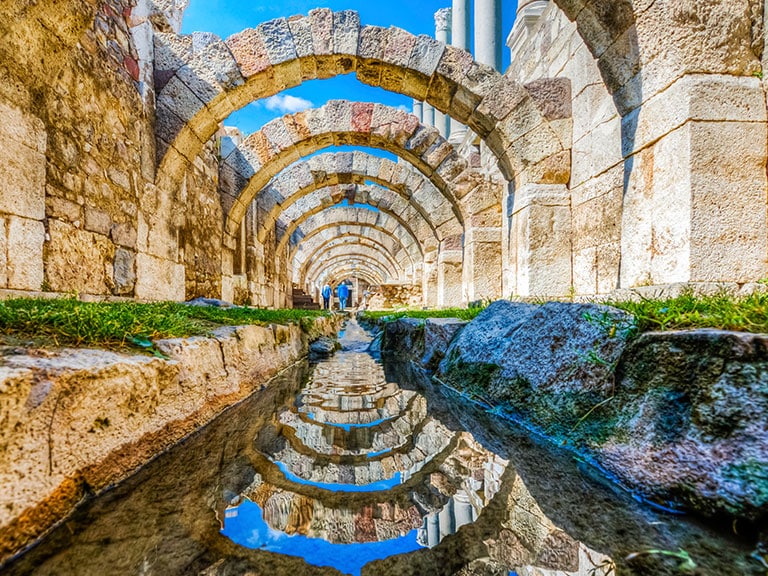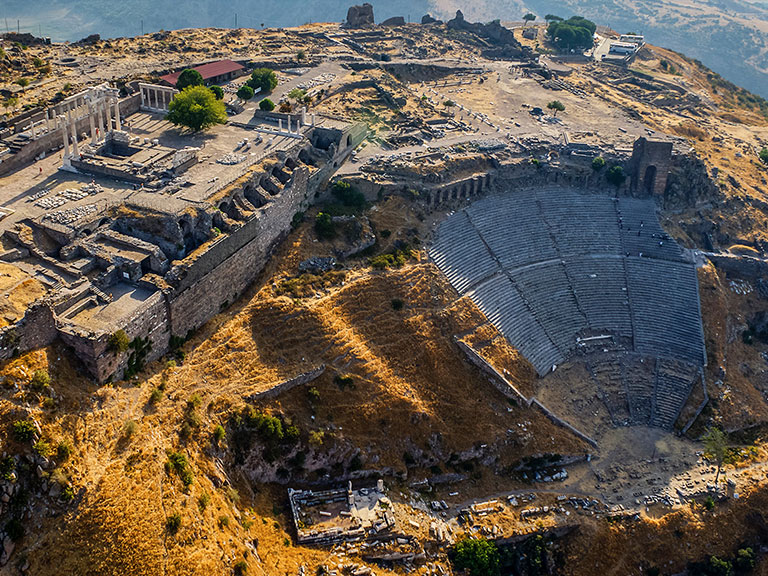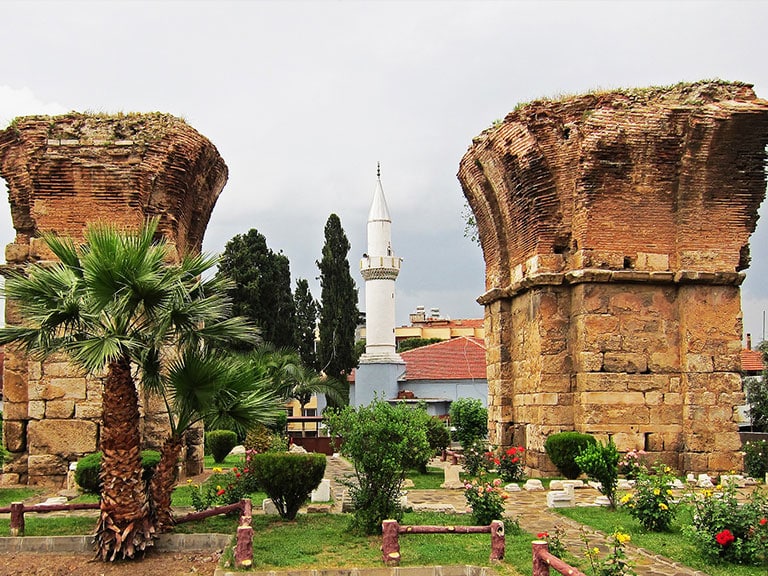If you grew up in the Christian church, chances are you’ve heard of the Revelation is higher. This apocalyptic book at the end of the Bible is filled with strange imagery and predictions of doom. But, before the four horsemen of the apocalypse ride in, the author has a message for some people in particular.
John wrote the Revelation as a message to seven churches around the western region of modern-day Turkey. The seven churches of the Revelation have become a pilgrimage site for many modern Christians. Read on to learn more about these churches and where they are today.
A Brief History of the Revelation
Before we dive into each of the seven churches of Revelation, let’s talk a little about how Revelation came to be. Most of us know Revelation as the last book of the Bible that predicts the end of the world. And while it can be interpreted that way, knowing a little bit about when and how it was written may offer a different outlook on the book.
The Revelation was written by the apostle John, possibly the same man who wrote the Gospel of John. It was written while he was in prison on the island of Patmos for going against the will of the Roman Empire. At the time, the Romans were persecuting Christians and trying to defeat the new movement.
John’s Revelation would have been reviewed by Roman guards before being sent along to its final destination. He could hardly write a letter to the early churches saying, “Don’t worry, God’s going to bring us through this, and we’ll have our victory over the Romans in the end.” So instead, John used symbolism and allegory to get his message across.
The Revelation is packed full of symbols and references to the hope the early Christians should have that the Romans would eventually be defeated. Some people believe that the book of Revelation isn’t a prediction of the end of the world, as it seems at first glance. Instead, it’s a coded prediction of the triumph of the Christian church over the empire that persecuted them.
What are the Seven Churches of Revelation?
Let’s discuss why do the seven churches get two full chapters dedicated to them in Revelation? These churches were struggling under the persecution of the Romans and sometimes from their temptations and internal problems. These seven churches are the reason the Revelation was written in the first place.
After the Roman guards read the Revelation, they decided that it was nothing more than the ramblings of a madman. They sent it on to John’s requested destination: Ephesus, the first church on the list. After Ephesus received it, they made copies and shared those with the other churches on the list.
The seven churches of the Revelation are Ephesus, Smyrna, Pergamum, Thyatira, Sardis, Philadelphia, and Laodicea. These were important sites of early Christianity, and many of them were suffering heavily from persecution. Some others needed a reminder to stick to the right path of Christianity and not get distracted by the culture around them.

1. Ephesus
The first church on the list is the church at Ephesus, the city that would have been closest to the island of Patmos. Ephesus was a great city in the first century, the fourth-largest in the Roman Empire. It was home to about 250,000 people, and only Alexandria, Antioch, and Rome itself surpassed them.
Ephesus was home to the Temple of Artemis, one of the Seven Wonders of the Ancient World. Its amphitheater could hold 25,000 people and was once the site of an angry riot against Christians. Suffice it to say, being a Christian in ancient Ephesus was far from easy.
In Revelation, John praises the church at Ephesus for not giving in to a lot of persecution and for rejecting those who he calls false prophets. But he also tells them to come back to their first love and worship the way they once did. This leads some historians to believe that Ephesian Christians may have begun worshipping at local cult temples.
Today, the city of Ephesus has moved a few miles away from the coast and is some of the most glorious ruins of the Roman Empire. The nearby town of Selcuk serves as a home base for tourists looking to explore this once-great city. You can even see the Church of the Virgin Mary, the site where it is believed Jesus’s mother may have spent her last days.

2. Smyrna
Smyrna is the second church mentioned in Revelation. It’s another port city about forty or fifty miles north of Ephesus along modern-day Turkey’s coastline. Today the ancient city of Smyrna is contained within the modern metropolis of Izmir, a thriving city that’s home to more than four million people.
Smyrna was a significant seaport in its time and vied with Ephesus for one of the most important cities in the region. Even in those early days, Smyrna had a bishop, a disciple of John himself named Polycarp. But early Christians didn’t have it any easier in Smyrna than they did in Ephesus.
Frequently in Smyrna, Christian persecution took the form of financial hardship, with Christians losing jobs or having their wealth taken away. So John tells them in Revelation to remember the spiritual wealth they have rather than focusing on their lack of material wealth. He also warns them that there is persecution coming and tells them not to be afraid of it.
Today, the ruins of the Smyrna marketplace are nestled within just a few city blocks of Izmir. You can walk the beautiful arches of the market place and see the towering columns that would have hemmed in the market. It has been through earthquakes, fires, and war, but still, this site of early Christianity stands.

3. Pergamum
Pergamum, the third church of the Revelation, is the last coastal city on the list, a further sixty-odd mile up the coast from Smyrna. In the first century, Pergamum was the principal city of the Roman empire, and some of its ruins still stand on a hill overlooking the town of Bergama. Most striking of all is a steep theater built into the side of a cliff.
Pergamum also had a large temple to Zeus that even today is a fantastic sight to see. The Asclepion of Pergamum was the most famous medical center in the world in the city’s heyday. At its height, Pergamum was only a little smaller than Ephesus, with around 200,000 inhabitants by the second century.
John’s message to the church at Pergamum is a little harsher than what he wrote to the other two cities. He calls their city “the place where Satan has his throne”, possibly a reference to the temple to Zeus. He praises some people for holding to their faith, but he tells others to repent, or he’ll come soon to fight against them.
Today, Bergama spreads out in the valley below the hills of ancient Pergamum. There is a part of the older city with more narrow, cobbled streets and a more modern area of the town. Today, there are no Christian churches active in Bergama, but few Christians spread through the area.

4. Thyatira
The fourth church John writes to in Revelation is the church at Thyatira. This city was to the southeast of Pergamum, and we see the path John’s manuscript may have taken beginning to loop back down around and move further into inland Turkey. Thyatira was also the only city of the seven built on flat ground with no natural defenses around it.
Thyatira was a city of artisans, home to several guilds, including linen weavers, potters, bakers, and more. But one of the biggest trades in Thyatira was the bronze trade. John used this knowledge to get his message across to the Christians living in Thyatira.
John begins his message to the church at Thyatira, praising the love, faith, service, and perseverance of the Christians there. But then he moves to condemn Jezebel, a woman who he says misleads Christians into sin. He says that God will strike her children dead and that only those who do not hold to her teachings will be saved.
Today Thyatira is only a few scant ruins in the modern city of Akhisar. Akhisar is known for its olive and textile industries and today is home to more than 100,000 people. You can see ancient walls scattered among modern apartment buildings and can walk the ground where Paul and Silas may once have preached.

5. Sardis
The fifth city in John’s letter, Sardis, had already seen some hard times by the time the Revelation was penned. Nonetheless, it had rebuilt itself to become one of the most prosperous cities in the region by the first century. It was a few dozen miles south of Thyatira, east of Smyrna, and northeast of Ephesus.
There was a temple to Artemis in Sardis and, just a short way away, the most significant ancient Jewish synagogue in the world. There were also shops and a stadium in the area surrounding these sites of worship. The temple to Artemis had been destroyed in a devastating earthquake several hundred years before, and Alexander the Great had begun to rebuild it. Still, when Christianity entered Sardis, the temple was all but abandoned.
Unlike in the other letters, John doesn’t have much praise for the church at Sardis. Instead, he opens by telling them that they have a reputation for being alive when they are dead. He implores them to wake up and strengthen what remains, for their work is still unfinished.
Today the ruins of Sardis sit just a few miles outside the town of Sart. Sart is a small village, with only five thousand residents or so, but you can still see the ruins of the temple to Artemis and the Jewish synagogue. You can also find the remains of the church that John implored to wake up, a message that seems to have been heard by at least some.

6. Philadelphia
Philadelphia is the sixth of the churches of Revelation, and it wasn’t far from Sardis. Philadelphia is only about thirty miles southeast of Sardis and today is covered by the modern city of Alasehir. The church at Philadelphia was the youngest John wrote to, as the city itself wasn’t established until the middle of the second century.
John has nothing but praise for the church at Philadelphia. He tells them that God has placed an open door before them that no one can shut and that their enemies will fall at their feet and acknowledge that God loves them. But this promise did not save Philadelphian Christians from persecution; several of them are believed to have been killed alongside Polycarp, the bishop of Smyrna.
The ancient architecture blends into the new scenery, and you can hear Muslim calls to prayer as you walk among the ruins of abandoned Christian churches. There are stunning Byzantine arches and ancient sarcophagi that you can view spread throughout the city. But Alasehir is a predominantly Muslim city today, much like the rest of Turkey.

7. Laodicea
The last church John writes to is the church at Laodicea. This city was further southeast of Philadelphia and almost due east of Ephesus. It was an expansive, wealthy city situated near hot springs and built on a major highway.
Laodicea’s central location made it a commercial and banking center specializing in medicine and the black wool trade. John used these trades in his admonishments to the Christians at Laodicea.
John tells the church at Laodicea that they are neither hot nor cold and don’t know what real wealth is. He encourages them to repent and promises rewards of real wealth to those who do.
Today the ruins of Laodicea are near the modern city of Denizli. The ancient town was heavily damaged in an earthquake in 600 AD, but you can still walk some of the roads and see the ruins of the historic buildings. The nearby city Denizli is home to about 500,000 people.
Discover the Seven Churches of Revelation for Yourself
The Seven Churches of Revelation were in desperate need of hope and guidance when John wrote to them. His message gave them that hope through allegories they would understand. And today, the ruins of those cities and their churches serve as a powerful reminder to Christians of what the early church endured.
If you’d like to see these seven churches for yourself, check out this sample biblical tour of Turkey covering the seven churches. We have different options for a small group tour or a private guided tour in all the major historical areas of Turkey, including Istanbul, Troy, Ephesus, and more. Contact us today to discover the wonders of the ancient world for yourself.
